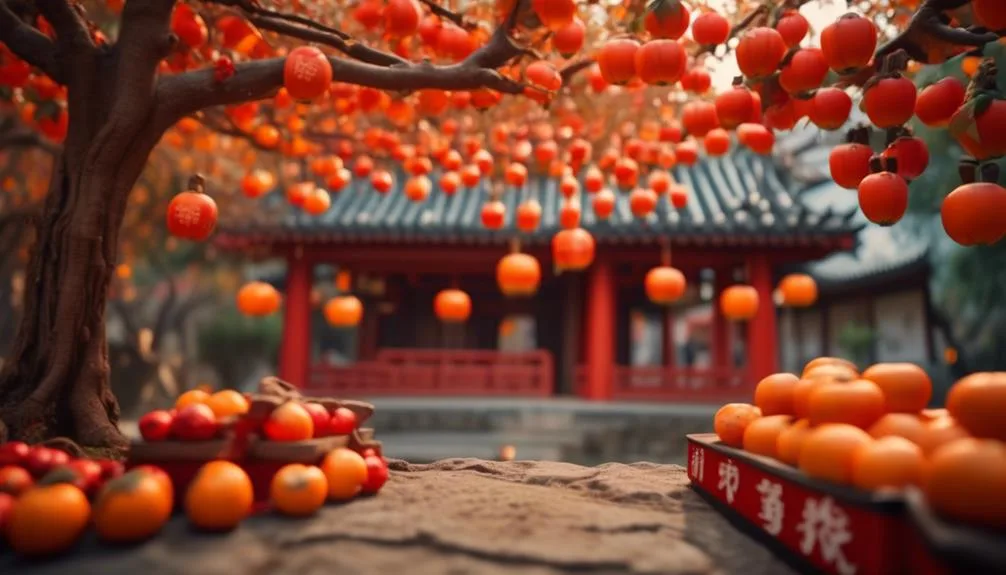Did you know that there are over 2000 types of persimmon trees in Asia?
These trees have been important in Asian culture for centuries, with symbolic meaning, traditional medicinal uses, and culinary significance.
But why are they so important?
Let's explore the various roles persimmon trees play in shaping Asian culture.
Key Takeaways
- Persimmon trees hold deep spiritual significance in Asian culture, representing longevity, transformation, and good fortune.
- The fruit of the persimmon tree symbolizes vitality and is associated with the sun, while the shedding of leaves and rebirth in spring mirrors the cycle of life.
- Persimmon trees have traditional medicinal uses, with the fruit aiding in digestion and cold symptoms, and the bark being used for high blood pressure and respiratory ailments.
- Persimmon trees play a diverse role in Asian culinary traditions, adding a rich and flavorful element to dishes and being incorporated in both sweet and savory recipes.
Symbolism in Asian Culture
In Asian culture, persimmon trees hold deep symbolic significance, representing longevity, transformation, and good fortune. These cultural beliefs stem from the tree's ability to bear fruit well into old age, symbolizing a long and prosperous life. The vibrant orange color of the fruit is also associated with the sun, signifying vitality and positive energy.
Moreover, the shedding of the tree's leaves in autumn and its subsequent rebirth in spring mirrors the cycle of life and transformation, further enhancing its spiritual significance. Many Asian traditions include the persimmon fruit in rituals and celebrations to bring good luck and prosperity to individuals and their families.
Understanding the spiritual significance of persimmon trees provides a glimpse into the rich cultural tapestry of Asian societies and their reverence for nature's symbols.
Traditional Medicinal Uses
The persimmon tree has been utilized for centuries in traditional Asian medicine, harnessing its fruits, leaves, and bark for their various healing properties and wellness benefits.
In folklore traditions, the persimmon fruit is believed to aid in digestion, relieve hiccups, and alleviate symptoms of the common cold.
The leaves of the persimmon tree are often used to make medicinal teas that are thought to have anti-inflammatory and diuretic properties, promoting overall wellness.
Additionally, the bark of the persimmon tree is used in traditional medicine to address issues such as high blood pressure and respiratory ailments.
These medicinal uses have been passed down through generations, demonstrating the enduring significance of the persimmon tree in Asian culture.
Culinary Importance
With its diverse array of uses in traditional Asian medicine, the persimmon tree also plays a vital role in Asian cuisine, offering a rich and flavorful addition to a variety of dishes. The persimmon fruit, known for its sweet and tangy flavor profiles, is used in both fresh and dried forms. When ripe, it can be eaten raw, added to salads for a sweet twist, or used in desserts such as puddings and tarts. In addition, persimmons can be incorporated into savory dishes, providing a unique sweetness when cooked with meats or used in chutneys and sauces. The cooking methods for persimmons include baking, grilling, and stewing. Below is a table summarizing the culinary importance of persimmons in Asian cuisine:
| Culinary Use | Flavor Profile | Cooking Method |
|---|---|---|
| Desserts | Sweet, Tangy | Baking |
| Salads | Sweet | Fresh |
| Savory Dishes | Sweet, Tangy | Grilling |
Role in Festivals and Celebrations
Adorning the streets with vibrant hues and bringing communities together, persimmon trees play a significant role in Asian festivals and celebrations, symbolizing abundance and prosperity.
Historical Significance: The presence of persimmon trees in festivals dates back centuries, signifying the deep-rooted cultural traditions and the enduring importance of nature in Asian societies.
Community Gatherings: During festivals, people gather around persimmon trees, engaging in seasonal rituals such as picking ripe fruits or offering prayers for a bountiful harvest. These gatherings foster a sense of unity and shared purpose within the community.
Symbolism of Prosperity: The rich, red-orange fruits of persimmon trees are often used as decorations, representing not only the beauty of the season but also the hope for a prosperous future, making them a central feature of celebratory events.
Cultural Significance in Art and Literature
In the realm of art and literature, persimmon trees inspire a rich tapestry of cultural expression, weaving through the narratives and brushstrokes of Asian creators with their vibrant symbolism and timeless allure. The persimmon tree has been a wellspring of artistic inspiration, depicted in traditional paintings and modern art forms, reflecting its historical significance and modern interpretation. In literature, the persimmon tree has been a subject of literary representation, often symbolizing transformation, perseverance, and the cycle of life. From ancient poems to contemporary novels, the persimmon tree continues to captivate writers and readers alike with its profound meaning. Below is a table showcasing the artistic and literary significance of persimmon trees:
| Artistic Inspiration | Literary Representation |
|---|---|
| Traditional paintings portraying the beauty and symbolism of persimmon trees | Symbol of transformation and perseverance in poetry and novels |
| Modern interpretations in various art forms, capturing the tree's timeless allure | Representation of the cycle of life and its significance in cultural narratives |
Conclusion
Persimmon trees are more than just a fruit source in Asian culture. They symbolize tradition, are utilized in traditional medicine, and are integral to culinary and cultural customs.
Their presence in festivals, art, and literature reflects the deep-rooted connection between nature and Asian society.
Beyond their fruit, persimmon trees embody the rich cultural heritage of Asia, reminding us of the enduring significance of tradition and nature in our lives.

